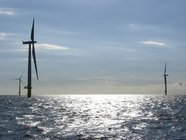
Since 2021, DOE and the Department of the Interior’s Bureau of Ocean Energy Management (BOEM) have been collaborating to advance offshore wind (OSW) off both the Atlantic and West Coasts in support of meeting the Biden-Harris Administration goal of deploying 30 gigawatts (GW) of OSW by 2030 and 15 GW of floating OSW by 2035, as well as unlocking a pathway to deploy 110 GW by 2050.
Planning and siting transmission infrastructure for offshore wind energy involves several Federal authorities, independent system operators and regional transmission organizations (ISO/RTOs), public utility commissions, state departments of fish and wildlife, and other community organizations in part because transmission needs to be sited both offshore and onshore.
Understanding the constraints related to shared use of new or existing transmission rights-of-way will allow transmission planning entities and siting authorities to make decisions using the best available information and science.
Funding from the Inflation Reduction Act has allowed DOE to extend offshore wind transmission efforts to the West Coast. In addition to this RFI, DOE and BOEM have been gathering input since January 2024 through a series of targeted convenings with Tribal Nations, federal and state agencies, cable and transmission providers, fisheries organizations, non-governmental organizations, developers, unions, utilities, and other entities to discuss the aspects of transmission planning which are most meaningful and applicable to them. For the purposes of this work, “West Coast” includes California, Oregon, and Washington states. Hawai’i and Alaska are not included in this work, as federal OSW efforts are not yet underway in those states.
Information gathered through the RFI and the convening series will be used to inform the West Coast Action Plan for Offshore Wind Transmission Development which will include a set of recommendations for addressing near-, medium-, and long-term OSW transmission challenges. With anticipated publication in early 2025, the recommendations will address technical planning, technology development, siting, policy, supporting initiatives, and partnerships that lead towards effective design and implementation of OSW transmission.
In February 2023, DOE released the West Coast Offshore Wind Transmission Literature Review and Gaps Analysis, which summarizes publicly available transmission analyses for West Coast OSW and identifies gaps in existing studies. The review finds a lack of information about floating transmission technology, a gap in identifying feasible offshore cable routes, and limited prioritization of interregional coordination in transmission planning.

